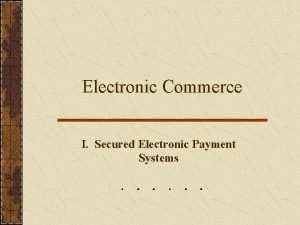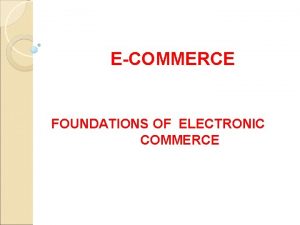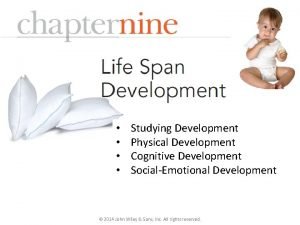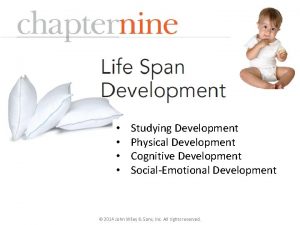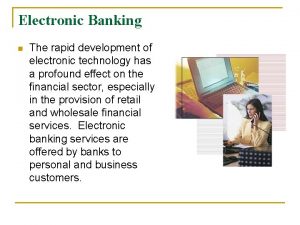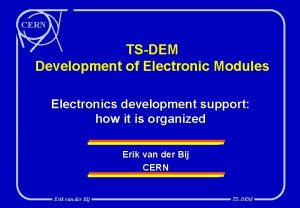The development of skinlike electronic devicesEskin eskin electronic
















![citations • • • [1] K. H. Lee, M. S. Kang, S. P. Zhang, citations • • • [1] K. H. Lee, M. S. Kang, S. P. Zhang,](https://slidetodoc.com/presentation_image_h2/5924e829ada750ed64aed4e53a0b640f/image-17.jpg)

- Slides: 18

The development of skin-like electronic devices(E-skin) e-skin: electronic devices with flexible&stretchable networks and sensing functionalities that akin to human skin Yuhang Sun April/15/2016

Basic sense Touch (tactition) Sight Movement (vision) (balance) sense Hearing Taste (audition) (gustation) Smell (olfaction) Skin: largest sensory organ in human body , full of different types of sense receptors.

Outline • Originality • Materials mainly used • Four Transduction mechanisms • Novel Desirable Properties for E-Skin

originality applicable for autonomous artificial intelligence(robots) apply on/in human body to provide an unprecedented level of diagnostic and monitoring capabilities Luke skywalker was installed a hand with full sensory receptions

First e-skin in history • In 1985, General Electric(GE) built the first sensitive skin with 64 infrared sensor pairs on it, the resolution is 5 cm.

Materials & Considerations Goal: mechanical compliant(flex & stretch) Materials How to make it stretchable

1. Dielectrics(elastomers, polymers) • With addition of inorganic high k particles, especially suitable for flexible transistors. Elastomers(PDMS, PVDF)mixed with (Ti. O 2, Ba. Ti. O 3 or ionic liquid) PVDF+inoic liquid by Lee’s group [1]

2. CNT based or Graphene based active material • Carrier mobility: CNT: 10000 cm 2 V-1 s-1, graphene: 20000 cm 2 V-1 s-1 Graphene films deposit on Ni film(left)&Si. O 2(right)substrate by CVD[2]

3. Nanowire based-active materials Difficult to fabricate NWs into ordered array, LBL make it possible for NW to integrated on flexible substrate; expensive Layer by Layer(LBL) assembly for 3 D structure Nam’s group [3]

Transduction mechanism • 1. Piezoresistivity • transduce a change in the resistance of a device into a measurement of strain • Most extensively investigated • have been incorporated into highly flexible and stretchable devices using connections made from liquid metal, stretchable helical electrodes, stitched metallic electrodes

2. capacitance • C = ε 0 ε r A / d, • The change in d is commonly used to measure normal forces, • changes in A are typically used to measure shear forces • This method is not widely pursued: • I. reducing the pixel size of these devices for miniaturization reduces the capacitance and the signal-to-noise ratio • II. capacitive sensors are susceptible to interference from external sources

3. Piezoelectricity • Piezoelectricity refers to the ability of a material to generate a voltage in response to an applied force. • The force causes a change in the length and separation between dipoles in the material, leading to the build-up of compensating charges on the electrodes • Most popular piezoelectric materials: PZT(lead zirconate titanate)&Zn. O

4. Optics • convert a tactile input into an electrical output using light as an intermediate • Consist of light source, transmission medium, and detector Work reported by Bao’s group

Novel Desirable Properties for E-Skin • 1. biodegradable

2. Highly-integrated & 3. wireless detection • Which means e-skin can be transferred onto human body in a manner similar with human skin. it’s like a tattoo, made based on a water soluble based PVA, it can

Other ones • 4. self-powered • 5. self-healing • 6. temperature-detection • ……
![citations 1 K H Lee M S Kang S P Zhang citations • • • [1] K. H. Lee, M. S. Kang, S. P. Zhang,](https://slidetodoc.com/presentation_image_h2/5924e829ada750ed64aed4e53a0b640f/image-17.jpg)
citations • • • [1] K. H. Lee, M. S. Kang, S. P. Zhang, Y. Y. Gu, T. P. Lodge, and C. D. Frisbie, ""Cut and Stick" Rubbery Ion Gels as High Capacitance Gate Dielectrics, " Advanced Materials, vol. 24, pp. 4457 -4462, Aug 2012. [2] A. Reina, X. T. Jia, J. Ho, D. Nezich, H. B. Son, V. Bulovic, et al. , "Large Area, Few-Layer Graphene Films on Arbitrary Substrates by Chemical Vapor Deposition, " Nano Letters, vol. 9, pp. 30 -35, Jan 2009. [3] A. Javey, S. Nam, R. S. Friedman, H. Yan, and C. M. Lieber, "Layer-by-layer assembly of nanowires for three-dimensional, multifunctional electronics, " Nano Letters, vol. 7, pp. 773 -777, Mar 2007. [4] J. A. Rogers, "Epidermal electronics, " Abstracts of Papers of the American Chemical Society, vol. 243, p. 1, Mar 2012. [5] X. L. Wang, H. Hu, Y. D. Shen, X. C. Zhou, and Z. J. Zheng, "Stretchable Conductors with Ultrahigh Tensile Strain and Stable Metallic Conductance Enabled by Prestrained Polyelectrolyte Nanoplatforms, " Advanced Materials, vol. 23, pp. 3090 -+, Jul 2011. [6] K. S. Kim, Y. Zhao, H. Jang, S. Y. Lee, J. M. Kim, K. S. Kim, et al. , "Large-scale pattern growth of graphene films for stretchable transparent electrodes, " Nature, vol. 457, pp. 706 -710, Feb 2009.

Five key points • • • 1. what is e-skin(definition) 2. originality of developing e-skin(two aspects) 3. three main types of materials used 4. four transduction methods 5. novel properties
 Is the electronic exchange of money or scrip
Is the electronic exchange of money or scrip Electronic news gathering and electronic field production
Electronic news gathering and electronic field production Hình ảnh bộ gõ cơ thể búng tay
Hình ảnh bộ gõ cơ thể búng tay Frameset trong html5
Frameset trong html5 Bổ thể
Bổ thể Tỉ lệ cơ thể trẻ em
Tỉ lệ cơ thể trẻ em Gấu đi như thế nào
Gấu đi như thế nào Tư thế worm breton
Tư thế worm breton Hát lên người ơi alleluia
Hát lên người ơi alleluia Môn thể thao bắt đầu bằng chữ đua
Môn thể thao bắt đầu bằng chữ đua Thế nào là hệ số cao nhất
Thế nào là hệ số cao nhất Các châu lục và đại dương trên thế giới
Các châu lục và đại dương trên thế giới Công thức tính độ biến thiên đông lượng
Công thức tính độ biến thiên đông lượng Trời xanh đây là của chúng ta thể thơ
Trời xanh đây là của chúng ta thể thơ Cách giải mật thư tọa độ
Cách giải mật thư tọa độ Làm thế nào để 102-1=99
Làm thế nào để 102-1=99 độ dài liên kết
độ dài liên kết Các châu lục và đại dương trên thế giới
Các châu lục và đại dương trên thế giới Thể thơ truyền thống
Thể thơ truyền thống























